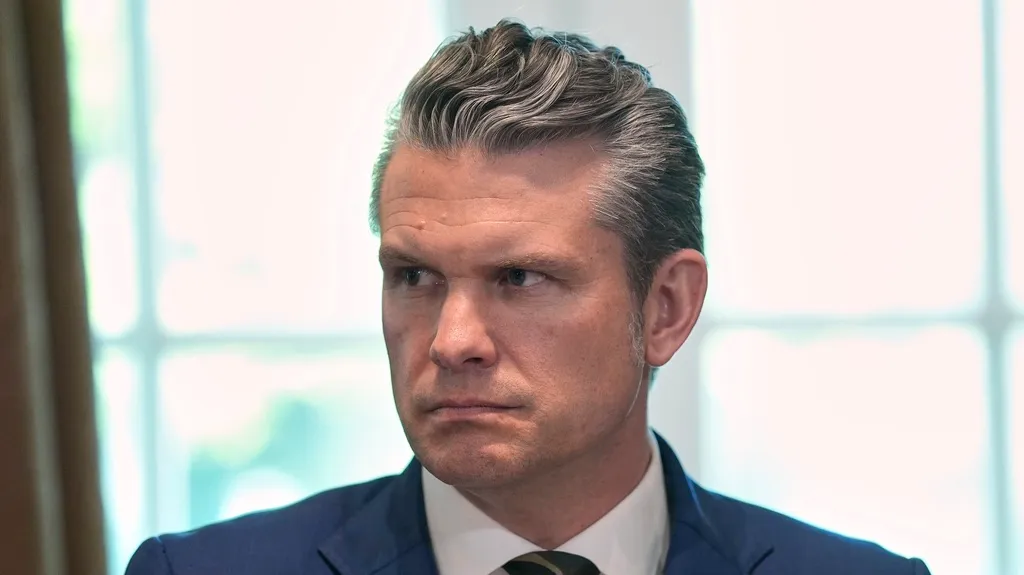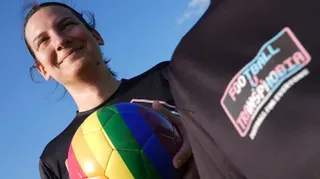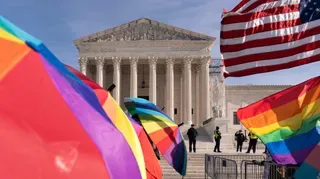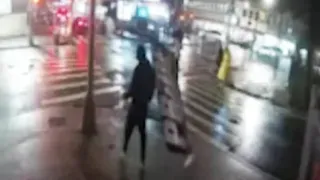May 12, 2008
Gay Books for Kids: Censoring Lesbian Moms & Penguin Dads
Scott Stiffler READ TIME: 11 MIN.
When was the first time you saw a portrayal, positive or otherwise, of LGBT existence? If you came of age before the Internet, chances are it was an exaggerated sitcom character or a tragic victim of AIDS -- hardly encouraging for a young person questioning their sexuality or forming an opinion of LGBTs. It's good to know, then -- the next time you see two gay men pushing a stroller and doting over their little bundle of joy -- that the kid's toy chest will likely include books depicting LGBT families along with staples like "Goodnight Moon" and "Where the Wild Things Are."
Two, Twenty-One, or Never?
But what age is appropriate to begin introducing the concept of families headed by those whose identity is so closely associated with their sexuality? Depending upon your political and religious affiliation, it's somewhere between two, twenty-one and never. Aaron Cooper, Ph.D. (author of "I Just Want My Kids To Be Happy: Why You Shouldn't Say It, Why You Shouldn't Think It, What You Should Embrace Instead") believes that early childhood is the best time to start cultivating a favorable attitude towards LGBTs: "A few positive words in a child's storybook may contribute to a picture of good mental health for a youngster discovering his or her LGBT status. Before children and teens are necessarily able to identify their own sexual orientation, the exposure to positive portrayals of LGBT people can make the difference between self-hate or self-acceptance if they later discover that they don't fit the heterosexual model. It also lays a foundation that becomes the basis for us to be able to reach out with understanding when, in our own lives, someone we know identifies as LGBT."
Cooper suggests that a good barometer of what's appropriate for a specific age group is to ask how heterosexual orientation is presented. "If literature for pre-schoolers portrays a family with parents identified simply as Mom and Dad, then it makes sense to create literature for pre-schoolers with LGBT parents. If literature for middle schoolers portrays a boy and girl holding hands as they walk home from school, then comparable literature might portray two girls holding hands." Young children, notes Cooper, "accept the fact of LGBT existence without judgment or criticism" before the influence of church, family and stereotypes begins to shape and sway their beliefs.
Many still regard any positive mention of LGBTs as indoctrination (although given its definition, one could argue that everything from toilet training to learning the alphabet song is indoctrination). Deborah T. Meem, PhD, Professor of English and Women's Studies; Co-director of Graduate Studies, Women's Studies, University of Cincinnati, finds the very question as to whether LGBT books for children are propaganda to be "hostile and insulting, because it assumes that LGBT-themed books have an agenda that straight-themed books do not. From McGuffey's readers to Dick and Jane and beyond, American children's books have always had as an overt purpose the correct socializing of kids into a straight, white, middle-class culture of sexism, heterosexism, and consumerism."
But even when indoctrination crosses the line to become ideological recruiting or propaganda, those who bristle at the values children other than their own are taught needn't worry. Precious toddlers who dutifully recite what they're told inevitably grow up to become savvy tweens and disenchanted teens who question or reject what their parents taught them. Meem: "By the time young children have grown into adolescence, they are presumably ready for more complex portrayals of life, and at this time books shift to 'problem' themes (drugs, abuse, and yes, even homosexuality). A youngster's sexual confusion may qualify as a 'problem' in this sense, and may not be shown as populated by 'positive images' of gayness. This, however, is no different than other adolescent problem fiction, which typically shows a young person encountering the outside world -- in its goodness and badness -- for the first time."
Two Trailblazing Books
Meem points out that trailblazing books such as "Heather Has Two Mommies" and "Daddy's Roommate" "seemed 'propagandistic' to right-wing homophobes who sought to protect children (and others) from contagious homosexuality. And maybe an argument can be made that these two books did have a didactic function in terms of seeking acceptance for gay families in a hostile world." Today, Meem cites a significantly changed marketplace and culture where a new generation of children's books such as "'King & King' and 'Antonio's Card' tell stories of children making brave choices -- and the fact that the brave choices take place in an LGBT context is less aggressively indicated, and more part of an intersectional presentation that characterizes the books generally."
Heather and Tango: Censoring Lesbian Moms & Penguin Dads
Originally published in 1989, "Heather Has Two Mommies" was the first children's book portraying LGBT families to receive both national acclaim and scorn. Written by Leslea Newman and illustrated by Diano Souza, "HH2M" was cited by the American Library Association as its eleventh most frequently banned book throughout the 1990s. Packed with such hot button topics as lesbian mothers (one of whom is a carpenter!) and tolerance, the book drew the ire of concerned parents and conservative politicians (such as Jesse Helms who, in 1994, co-sponsored a bill to ban schools receiving federal funds from carrying out programs encouraging alternative lifestyles). That it got published at all, given the times, is something of a miracle. Newman recalls: "I sent the book out to many publishers, none of whom were interested. Publishers said they acknowledge a need for this kind of book, but they weren't willing to be the one to take it on. A friend had a desktop publishing business. We raised four thousand dollars, all in ten dollar donations. We took my mailing list, and got a letter saying if you send us ten dollars, we'll send you a book in one year or your money back."
In the beginning, reaction and sales were fairly low key: "At that point, there were many feminist bookstores in the country and they started calling, ordering the book. At that point, the people who were interested were lesbian moms and nobody else really knew about the book." In 1990, Alyson Publications bought the book from In Other Words Publishing. "Sasha Alyson had published 'Daddy's Roommate' around that time, and came across 'Heather Has Two Mommies' in a Cambridge bookstore. My business partner and I were only too happy to have him take over. That's when mainstream am got wind of this, some people weren't happy." Reacting to the overused and much-abused cries of foul from those unhappy that their tax dollars were going to support schools or libraries which included 'HH2M,' Newman points out that this justification for protest "ignores the fact that LGBT people pay taxes like everybody else. They started challenging the book, lodging formal complaints to the librarian. Libraries all have a process they go through when a book is challenged, and that complicates things. In schools, the Rainbow Curriculum was going on in New York; something the Chancellor put together to support multicultural education. 'Heather Has Two Mommies' and 'Daddy's Roommate' were included, and that cause all kinds of problems."
Almost twenty years later, all kinds of problems were being caused by a more innocuous (but no less contentious) book that chronicled the formation of an unconventional family. Published in 2005, And "Tango Makes Three" was inspired by a New York Times article about two male Chinstrap penguins in the Central Park Zoo who, after trying to hatch a rock, were given an egg. The queer tuxedo-clad couple (Roy and Silo) soon hatched and raised a female chick named Tango. David Gale, VP, Editorial Director of Simon & Schuster books for young readers, acquired and edited "Tango." Gale, who didn't and does not see it as a gay and lesbian themed book, bought it "because it works for any kid who is adopted, and any kid because it is a strong picture book in its own right. It's a good book about penguins which kids love and its based on a true story about family love."
And yet, it also has undeniable queer content and appeal. Gale, who points out that male/male and female/female bonding is not unusual in the penguin world, does note that Roy and Silo's relationship is rare because "If at the end of the season they have not laid an egg, they partner with somebody else. These two male penguins were together for seven years without having an egg. Along the way, they exhibited nesting behavior. The zookeeper saw this and gave them an egg and they sat on it and raised a chick and remained together. That's an extraordinary story. For any kid to read it, if you are a child of same sex parents, you can see yourself in the book. If you are a child of a male/female couple, you can see other people and learn tolerance."
From the moment it was published, "Tango" sold incredibly well and was favorable reviewed by four of the five major sources for children's books. It was also an American Library Association notable book. In 2006 and 2007, however, it was the number one book on the American Library Association's list of challenged books. Gale notes the reasons cited were its "sexism, homosexuality, anti-family, religious and anti-ethnic viewpoint and unsuited to age group." Recently, the book was challenged in Loudoun County (VA). "Somebody challenged it in their district; the ruling was that it should stay on the shelves, but the Superintendent overruled the decision and made them put the book in a section that kids cold only access with a note from their parents. It caused a lot of controversy, and was the front page of the Washington Post several times over a few weeks. There was a big town meeting with a lot of press. The Superintendent said the challenge came from a teacher's aid, not a parent and was not a valid challenge, so he put it back on the shelves."
Although it was an educator in that particular case, Cooper traces much of the conflict over LGBT books for children directly back to worried and uninformed parents who "demand that their children's school libraries and community libraries ban such books from the shelves. They fear that the mere exposure to the fact of homosexuality might be enough to influence their youngsters in that direction. It's a sexual-orientation-by-contagion view, reflecting an ignorance about the origins of our sexual development. When is sex education in our schools going to include accurate information about how our sexual orientation develops?"
Scott Stiffler is a New York City based writer and comedian who has performed stand-up, improv, and sketch comedy. His show, "Sammy's at The Palace. . .at Don't Tell Mama"---a spoof of Liza Minnelli's 2008 NYC performance at The Palace Theatre, recently had a NYC run. He must eat twice his weight in fish every day, or he becomes radioactive.







